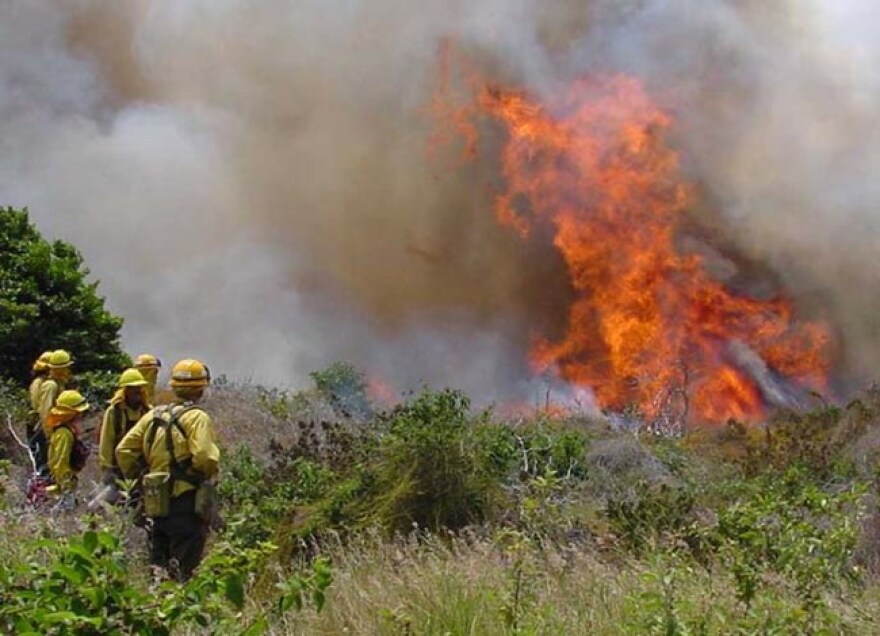Each year, an estimated 500 to 600 wildfires sweep across parts of Oahu. But those fires are different than the ones that burn on the mainland, and in many ways, the charred fields are just the beginning of the problem.

Clay Trauernicht is a wildland fire specialist at University of Hawaii, M?noa, and a leader of the Pacific Fire Exchange, tracking fires and the response to them through the Pacific region. He says Hawai‘i’s fires are unique.
“One of the impacts that distinguishes fires in Hawai‘i from the rest of the mainland is, once you get an area that’s burned, it just opens up an erosion problem.”
Hawai‘i has undergone huge land use changes since the 1970s. Sugar, pineapple, and ranching are gone and our wildfire incidence has skyrocketed 400%.
“All these fallow lands that we’re no longer using, you get these big fires. They burn out all this grassland and shrub land. They kind of erode the edges of our watershed for us," says Trauernicht. "That grassland expands over the long term and you lose forest cover. In the short term, all of that soil is now completely exposed to rainfall and you get these big sediment loads being carried out to the reef.”
Trauernicht says Oahu’s 500 to 600 wildfires per year is astronomically high and unmatched in the literature he’s studied. He doesn’t know exactly why Oahu has so many wildfire ignitions; some are rubbish fires that expand, some happen near homeless settlements. These include little flare ups on grassy patches all the way to the wildfires that have blazed through the West side. Trauernicht says the vast majority of Oahu’s fires are started by humans, and 20% are deliberately set.
Climate change predictions indicate the peak zone for fire susceptibility will get wider and shift mauka, putting more of our natural resources in danger. Fighting fires in mauka terrain can get expensive, since it usually relies heavily on helicopter water drops.
Trauernicht says discussions are beginning about whether and when fires might be allowed to burn out because of the cost and danger of fighting them.
In general, dry conditions with low humidity make ignition more likely. Days when heat and low humidity last into the night can encourage fires to burn through the evening, too. Until recently, fires would reliably dampen come sun down. These and other factors, plus new acreages falling under their responsibility, create a complex situation for firefighters.
Trauernicht says the short-term solution is creating firebreaks and trying to manage the rolling fields of fuel that now spread across the islands. Long term, he says, the answer is planting trees.
“Tree planting, it sounds so simplistic, but it’s one of these actions that will reduce fire risk, increase watershed health and integrity, and protect downstream resources. You could imagine Hawai‘i becoming a model for these actions where you can capture carbon that’s being emitted into the air."
Trauernicht points to the Civilian Conservation Corps in the 1930s, which tackled the problem of severe deforestation head on. He says goats had severely damaged watersheds across the islands and both the public and the government mobilized to fund planting millions of trees every year.
“A lot of that was coming from the federal government, but it’s within our capacity to do it. We’ve got this incredibly diverse and inspirational group of watershed partnerships and other folks that are doing this work. We have a lot of super dedicated people who are already devoting their lives to this thing, but they’re all struggling for funding. When people are actually willing to invest in these practices, there are multiple benefits that will come out of this.”
According to Trauernicht, "ecological engineering" is a way of working with the land for these multiple benefits. Services provided could include cultural value to products, and ecosystem balance. Trauernicht maintains it is up to the public to demand these services. (The latest IPCC report focuses on the role of land and land use in climate change. This is the topic of the next Planet808.)
Asked whether we have those terrifying California-style fires to look forward to, Trauernicht says Hawai'i hasn't seen humidity in the teens that drives fire intensity like that. We haven't had the winds, either, largely because Hawai'i doesn't have the landscape or land mass to create those conditions.
Check Hawaiiwildfire.orgfor details on fire prevention, along with drought and risk updates.
Planet808 is a series on climate change and its impacts on Hawai'i.




